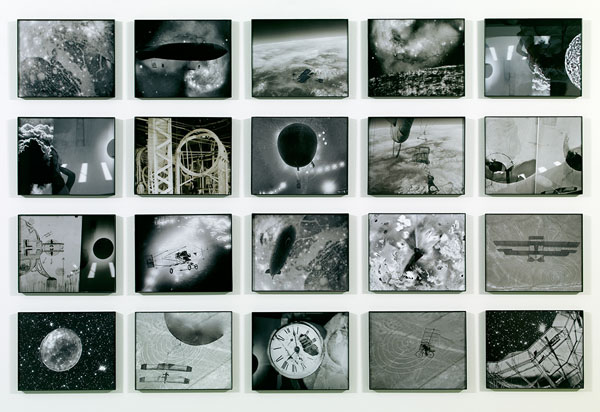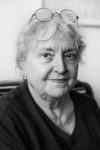
Michelle Stuart
American, 1933-
Land/Space/Time, 2011
20 inkjet prints
8 1/8 × 10 1/8 × 1/2 in. each
SBMA, Museum Purchase, General Art Acquisition Fund
2013.20a-t

Photo of Michelle Stuart, 2016
COMMENTS
PRESS RELEASE from LESLIE TONKONOW ARTWORKS + PROJECTS where Land/Space/Time was originally exhibited in Michelle Stuart Palimpsests September 6 – October 27, 2012
The forensic-archeological term palimpsest, defined as "something reused or altered but still bearing visible traces of its earlier form" can be seen as the operative metaphor for Michelle Stuart's entire body of work, from the pioneering Land Art pieces of the late 1960s and 1970s to the paintings, drawings, sculpture and mixed-media objects that have followed to date. That she has chosen Palimpsests as the title for her first solo show of works composed exclusively of photographic images is especially apt in its description of her newest works and their relationship to the evolution of her art and ideation.
The exhibition will include eight major works produced during the past eighteen months, each composed of between fifteen and sixty separate images, digitally printed on 8 x 10 inch sheets of archival paper and organized into grids. The individual panels feature altered and untouched, original and appropriated photographs derived from her vast pictorial repertory, as well as photographs she has made of collected objects from the magnificent Wunderkammer that is her home and studio.
Since the 1960s, Michelle Stuart's ardent curiosity about the natural world, fascination with the cosmos, and lifelong commitment to social justice have emerged in works of art that transcend geographical, philosophical, and aesthetic boundaries. She has produced “drawings" that are also "sculpture"; "paintings" that are also “drawings"; and, most recently, "photographs" that can not be exactly defined as such. She brings the world outside into the theoretical and physical space of the studio where she works and lives among the souvenirs of lifelong travels that span the globe. She collects and creates meaningful objects and images, using things gathered from a panoply of sources: seeds and wildflowers from the South Fork of Long Island, earth from the Nazca Plains in Peru, Georgia clay, stones from the South Pacific, ancient ledgers, feathers, dried reptiles, old albums, original photographs, and images harvested from the Internet.
Stuart's passion for photography (in her words “the most mysterious thing”) has been in evidence in her work since the late 1960s, most often in concert with drawings and rubbings or within grids of snapshot-sized prints that document the earth's stratifications and color variations in site-specific works of the 1970s. The newest pieces – a confluence of images, ideas, and objects – are the results of a lifetime of selecting, preserving, recording, and reporting. In them one encounters ruminations on war, human frailty, natural phenomena, metaphysics, traces of personal and political history, and a nod to surrealist cinema.
Fuerte Quemada: A Short Story (2011) recalls the uncanniness of films by Luis Bunuel. While We Went About Etherized (2012) harks back to T.S. Eliot's poem The Love Song of J. Alfred Prufrock, as a meditation on the callous disregard of human suffering. In Drawing on Space (2011), Stuart pairs close-up photographs of an antique camera lens with the celestial explosions of a fireworks display, suggesting the contrasting microcosm of artistic vision and the macrocosm of the world outside the studio.
Born in Los Angeles, Michelle Stuart lived in Mexico City and Paris before arriving in New York in the late 1950s, where she continues to live and work. Her art has been the subject of solo exhibitions at the Institute of Contemporary Art, London; the Walker Art Center, Minneapolis; the Haags Gemeentemuseum, The Hague; the Wadsworth Atheneum, Hartford; and many other major museums and galleries worldwide. She has participated in numerous group shows and international surveys, including documenta VI, Kassel. Her work is in the collections of The Museum of Modern Art, New York; the Whitney Museum of American Art, New York; the Museum of Contemporary Art, Los Angeles; the Moderna Museet, Stockholm; the Kaiser Wilhelm Museum, Krefeld; the San Francisco Museum of Modern Art; the National Gallery of Art, Washington, DC; the Museum of Contemporary Art, Chicago; the National Gallery of Australia, Canberra; and many other distinguished institutions.
Among the artistʼs many honors and awards are grants from the National Endowment for the Arts, the John Simon Guggenheim Foundation, and a residency at the American Academy in RoMaine
Works by Michelle Stuart are featured in Ends of the Earth: Land Art to 1974, on view through September 3 at the Museum of Contemporary Art, Los Angeles, and opening at the Haus der Kunst, Munich, on October 11, 2012; and Alice in Wonderland, which originated at the Tate Liverpool and remains on view at the Hamburger Kunsthalle through September 30, 2012. Michelle Stuart: Drawn from Nature, a major survey of works on paper from the 1960s to the present, will originate at the Djanogly Art Gallery, Lakeside Arts Centre, Nottingham, UK, on view from February 16 to April 14, 2013. It travels to the Santa Barbara Museum of Art and other venues to be announced. A monograph, published in connection with the exhibition, is forthcoming.
http://www.tonkonow.com/stuart2012_press.html
SBMA CURATORIAL LABELS
In the first decades of her artistic career, Michelle Stuart was widely recognized for her large-scale earthworks and her earth rubbings in which she smashed soil and rock into paper to trace the surfaces of various landscapes. This practice, which she began in the late 1960s, was largely inspired by the lunar landscapes of NASA’s early moon-mission photographs. The influences of astronomy and topography remain evident in this grid of twenty inkjet prints which captures the sublime aerial perspectives of aviation and space exploration.
- The Observable Universe: Visualizing the Cosmos in Art, 2019
